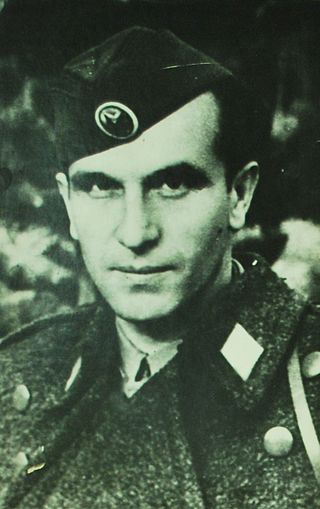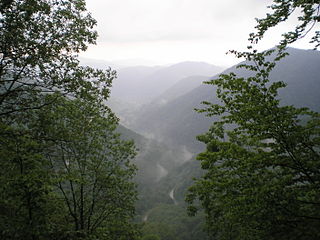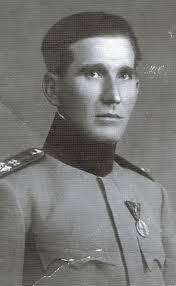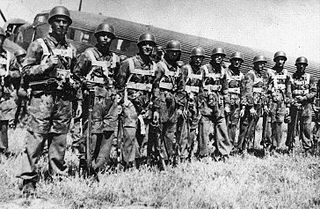
The Vardar Banovina, or Vardar Banate, was a province (banate) of the Kingdom of Yugoslavia between 1929 and 1941.

Kumanovo is a city in North Macedonia and the seat of Kumanovo Municipality, the largest municipality in the country. Kumanovo lies 340 metres above sea level and is surrounded by the Karadag part of Skopska Crna Gora mountain on its western side, Gradištanska mountain on its southern side, and Mangovica and German mountain on the Eastern side. Skopje airport also serves Kumanovo.
Karposh’s rebellion or Karposh’s uprising was a Christian anti-Ottoman uprising in the Central Balkans that took place in October 1689. Karposh, the rebellion leader, was born in the Sanjak of Üsküp in the then Rumelia Eyalet, Ottoman Empire, modern North Macedonia, probably in the village of Vojnik, under the name Petar. At a very young age, he escaped to Wallachia, present-day Romania, where he worked as a miner. Later, Karposh moved to the Rhodope Mountains, where he settled in the Dospat valley, becoming a notorious hajduk. After the army of the Holy Roman Empire advanced into the Ottoman Balkans, Karposh moved to the area of Znepole, and began to organise anti-Ottoman resistance detachments here.

The Serbs are one of the constitutional ethnic groups of North Macedonia, numbering about 24,000 inhabitants.

The Macedonian Partisans, officially the National Liberation Army and Partisan Detachments of Macedonia, was a communist and anti-fascist resistance movement formed in occupied Yugoslavia which was active in World War II in Yugoslav Macedonia. Units of the army were formed by Macedonians within the framework of the Yugoslav Partisans as well as other communist resistance organisations operating in Macedonia at the time and were led by the General Staff of the National Liberation Army and Partisan Detachments of Macedonia, headed by Mihajlo Apostolski.

Mihailo Apostolski was a Macedonian general, partisan, military theoretician, politician, academic and historian. He was the commander of the General Staff of the National Liberation Army and Partisan Detachments of Macedonia, colonel general of the Yugoslav People's Army, and was declared a People's Hero of Yugoslavia.

Dejan was a magnate who served Serbian Emperor Stefan Dušan as sevastokrator, and Emperor Uroš V as despot. He was married to Emperor Dušan's sister Teodora, and possessed a large province in the Kumanovo region, east of Skopska Crna Gora. It initially included the old župe (counties) of Žegligovo and Preševo. Uroš V later gave Dejan the Upper Struma river with Velbužd (Kyustendil). Dejan rebuilt the Zemen Monastery, one of Dejan's endowments, among others, as he also reconstructed several church buildings throughout his province.

The Operation Kopaonik was a large-scale Axis offensive launched against the Mihailović's Chetniks in Axis occupied Yugoslavia during World War II. The operation was inspired by Heinrich Himmler who believed that the annihilation of Draža Mihailović and his forces was a basis for a success in Serbia and South East Europe. Since Dragutin Keserović and his Rasina Corps was probably the most active commander of Mihailovićs Chetniks in Serbia, the newly established 7th SS Volunteer Mountain Division Prinz Eugen was engaged to participate in Operation Kopaonik to destroy Keserović and Chetnik unit under his command.
The Brsjak revolt broke out on 14 October 1880 in the Poreče region of the Monastir Vilayet, led by rebels who sought the liberation of Macedonia from the Ottoman Empire. According to Ottoman sources the goal of the revolt was the accession of Macedonia to Bulgaria. The rebels received secret aid from Principality of Serbia, which had earlier been at war with the Ottoman Empire, until Ottoman and Russian diplomatic intervention in 1881. The Ottoman Gendarmerie succeeded in suppressing the rebellion after a year.

The Serbian Revolutionary Organization or Serbian Chetnik Organization was a paramilitary revolutionary organization with the aim of liberation of Old Serbia from the Ottoman Empire. Its Central Committee was established in 1902, while the Serbian Committee was established in September 1903 in Belgrade, by the combined Central Boards of Belgrade, Vranje, Skopje and Bitola. Its armed wing was activated in 1904. Among the architects were members of the Saint Sava society, Army Staff and Ministry of Foreign Affairs. It operated during the Struggle for Macedonia, a series of social, political, cultural and military conflicts in the region of Macedonia; its operations are known as Serb Action in Macedonia.
Slavište, also known as the Kriva Palanka Plain, is a historical region around Kriva Palanka, in the northeastern part of North Macedonia, once by the medieval fortified town of Slavište, also known as Gradište, west of the modern town. The name Slavište is first mentioned in 1321, in the Gračanica charter of Serbian king Stefan Milutin, though it is believed to be older. During the Serbian Empire (1345–1371), the Slavište župa (county) consisted of the surrounding of modern-day Kriva Palanka which was the hereditary land of the Paskačić noble family. It was to the east of the Žegligovo župa, surrounding modern-day Kumanovo, and to the southwest of Osogovo, part of the land of the Dejanović noble family. In 1573, the Ottoman nahia of Slavište was recorded. The region is used in neotectonics.

Dragutin Keserović was a Yugoslav Chetnik military commander holding the rank of lieutenant colonel and vojvoda during World War II. Keserović was likely the most active commander of Mihailović's Chetniks in Serbia.
The Kumanovo uprising was an uprising organized by an assembly of chiefs of the districts of Kumanovo, Kriva Palanka, and Kratovo in the Vilayet of Kosovo in 1878. The movement sought to liberate the region from the hands of the Ottoman Empire. Following the Serbian Army's liberation of Niš on 12 January 1877, the rebellion began on 20 January 1878 with guerrilla operations during the army's liberation of Vranje. The rebels received secret aid from the Serbian government. The uprising lasted four months until its suppression by the Ottomans on 20 May, during which the Ottomans retaliated with atrocities on the local population.

Micko Krstić-Porečki, known as Vojvoda Micko, was a Serbian rebel and military leader active in the Poreče region.
Sredorek is a historical and geographical region in northeastern Republic of Macedonia. It includes settlements in the Pčinja river valley, parts of the mountainous regions of Kozjak (Kozjačija), German and Rujen, which are today located within the Municipality of Staro Nagoričane. The region is predominantly inhabited by ethnic Macedonians and ethnic Serbs, adherents of Eastern Orthodoxy. In the Middle Ages, the region was part of the župe (counties) of Žegligovo and Preševo.

Jovan Stanojković, known by his nom de guerre, the demonym Dovezenski (Довезенски), was a Serbian Chetnik commander (vojvoda), and participant in the Balkan Wars, in the Battle of Kumanovo, and World War I. He was originally a teacher who turned into a guerilla fighter following Bulgarian oppression on Serb people in Macedonia. He rose in ranks and became one of the supreme commanders in Macedonia.
Mladen Stojanović, known as Čakr-paša (Чакр-паша), was a Serb hajduk leader mostly active in the Ottoman territories of the Pčinja region and in the Kumanovo district, one of the most notable hajduks in the second half of the 19th century. A brigand since his teens, Čakr-paša deserted his guard service at the Serbian–Ottoman border in 1878 and became infamous in the following years for killing Ottoman officials, and also exploiting locals. Having survived the Serbian–Ottoman War (1876–78), Kumanovo Uprising (1878) and Brsjak Revolt (1880–81), his end came in 1885, after years on the run from both Ottoman soldiers and gendarmerie, and Serbian border guards, when his comrade slit his throat. After his death there were local stories of him as a fearless, stone-cold and raw individual, and also epic poems holding him a brave and sly hero.

The Stracin–Kumanovo operation was an offensive operation conducted in 1944 by the Bulgarian Army against German forces in occupied Yugoslavia which culminated in the capture of Skopje in 1944. With the Bulgarian declaration of war on Germany on September 8, followed by Bulgarian withdrawal from the area, the German 1st Mountain Division moved north, occupied Skopje, and secured the strategic Belgrade–Nis–Salonika railroad line. On October 14, withdrawing from Greece, Army Group E faced Soviet and Bulgarian divisions advancing in Eastern Serbia and Vardar Macedonia; by November 2, the last German units left Northern Greece.
The Rasina Corps was a corps of the Yugoslav Army in the Homeland (JVuO) that operated in the region of Kruševac county of Axis occupied Kingdom of Yugoslavia under command of Dragutin Keserović.

Mladen Žujović (1895—1969) was Serbian and Yugoslav attorney and professor of Law at Belgrade University. He was known as member of British-supported secret society Konspiracija and during the World War II as a member of the Central National Committee of the Kingdom of Yugoslavia and since 1943 commander of Yugoslav Army in the Fatherland in Dalmatia, Lika and Western Bosnia and Herzegovina.













